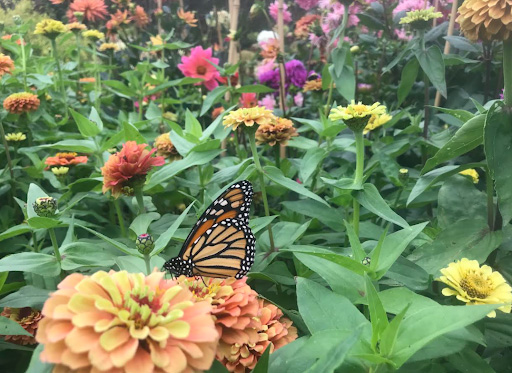So far into fall, we’ve experienced warm and pleasant weather – but as the days grow shorter, our lawns and gardens begin to move to crisper conditions. The island landscape continues to be full of life, including the hum and buzz of our native pollinators. And though their day-to-day activity indeed slows down this time of year, their work and preparation for next season are constant. Like our pollinators, we too could take these slower days to plan and consider how we can better accommodate them come next spring.
The Nantucket Land & Water Council launched its Planting for Pollinators Program this year. The objective is to educate and inspire a shift from manicured lawns to wild and natural landscapes that sustain all pollinators. The NLC put together an easy-to-follow guidebook, which provides step-by-step instructions on how to build your very own pollinator garden.
One way to establish a pollination site is to transplant native plants and shrubs to a designated area. These plants likely exist somewhere on your property. You could also select and purchase native plants that are fit for ultimate pollination from your local nursery.
Using native plants is an essential piece to the equation because it directly influences bee diversity and abundance. Another benefit to using native plants is the little maintenance and water they require. Also, zero fertilizer is needed to keep these plants thriving. Not only will your garden attract birds, bees, and butterflies, you’ll also be supporting and building a healthier ecosystem.
Since our program’s debut, several community members have converted their lawn or garden beds into pollinator sanctuaries. NLC’s Board President, Lucy Dillon, has taken much interest and pride in her pollinator garden. “I’ve been impressed not only with the minimal maintenance that my garden requires but how aesthetically pleasing the variety of native flowers and plants can be during all times of the year. Some of my favorites are milkweed, our wild roses and blueberry bushes, elderberry, and sumac, all of which draw in lots of activity from all different types of pollinators.”
When asked why she built a pollinator garden, Lucy said, “A pollinator garden is a great example of how doing very little (mowing or fertilizing) can greatly benefit our environment and produces so much beauty. It’s also a wonderful way to interact with nature.”
The Nantucket Land & Water Council will continue to offer opportunities for anyone interested in and inspired by the benefits of creating a pollinator garden. You can start by watching our Planting for Pollinators on Nantucket webinar, which can be found on our website. Our hope is that the conversion to a pollinator garden will be seen as a relatively simple endeavor.
Stay tuned for more details and register for our 2022 program today!

